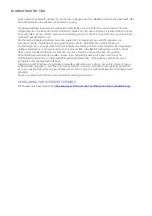
Instructions for Use
For disinfection, use only substances that do not have an impact on the synthetic material and metals
used.
If you fail to observe these provisions, you will be putting yourself into danger!
REGULAR CHECKS
Checking the equipment at regular intervals is absolutely necessary: your safety depends on the
effectiveness and durability of the equipment! Following each use, the rope and the eye termination in
particular should be checked for possible damage.
Check the eye of the termination with special attention: The whipping with lock stitches that prevent
the termination from gradually opening must be in place. The eye must not be longer than 25mm
(length measured inside the eye).
Systems that have been damaged or affected by a fall must be withdrawn from use immediately. If
there is the slightest doubt, the product must be withdrawn or inspected by an expert.
When using the equipment in occupational health and safety to EN 365, it must be checked at least
every 12 months by a duly qualified person strictly observing the instructions, or else by the
manufacturer, and it must, whenever necessary, be replaced. These inspections must be documented
(documentation of equipment; cf. attached Inspection Sheet). Refer to national regulations for
inspection intervals.
Such inspections must comprise:
–
Check of general state: age, completeness, discolouration, correct assembly
–
Check of label: Does it exist? Is it legible? Is there a CE marking? Does it specify the year of
manufacture?
–
Check of all individual parts for mechanical damage such as: cuts, cracks, indentations,
abrasion, formation of ribs, kinks, crushing.
–
Check of all individual parts for thermal or chemical damage such as: fusing, hardening.
–
Check of metal components for corrosion, deformations.
–
Check of condition and completeness of terminations, stitching (e.g. no abrasion of sewing
thread), splices (e.g. no slippage), knots.
Check the eye of the termination with special attention. In the eye, part of the rope core is removed
and there is less material to bear the load.
The whipping with lock stitches that prevent the termination from gradually opening must be in place.
The eye must not be longer than 25mm (length measured inside the eye). If the cover is damaged, the
product must be discarded:
–
Protruding fibers / yarns are a sign of abrasion.
–
Cuts provide evidence of rope damage.
–
Deformation and squashing may point to local overloading.
–
Melted or hardened parts are signs of thermal and / or chemical impact.
Again, the following rule applies: If there is the slightest doubt about the suitability of the product to
perform its required task, the product must be retired or quarantined and then subjected to testing by a
competent person.
MAINTENANCE
Repairs may be carried out only by the manufacturer.
SERVICE LIFE
Its theoretically possible period of use is up 7 years from the time when the product is first removed
from the undamaged package (only when used infrequently (1 week per year) and stored properly
(see Chapter “Transport, Storage and Cleaning”)). The product must be retired no later than after 7
years of use. It is assumed that the product will be removed from its package upon purchase. We
recommend keeping the sales receipt. The theoretically possible total lifetime (proper storage prior to
first r use) is limited to 10 years from the date of manufacture.
The actual useful life depends solely on the condition of the product, which in turn is influenced by
various factors (see below). Extreme influences may shorten service life to a single use only or to even
less if the equipment is damaged prior to its first use (e.g. in transport).
Mechanical wear and other influences such as the impact of sunlight will decrease the life span
considerably. Bleached or abraded fibers, discoloration, and hardened spots are certain indicators that




































